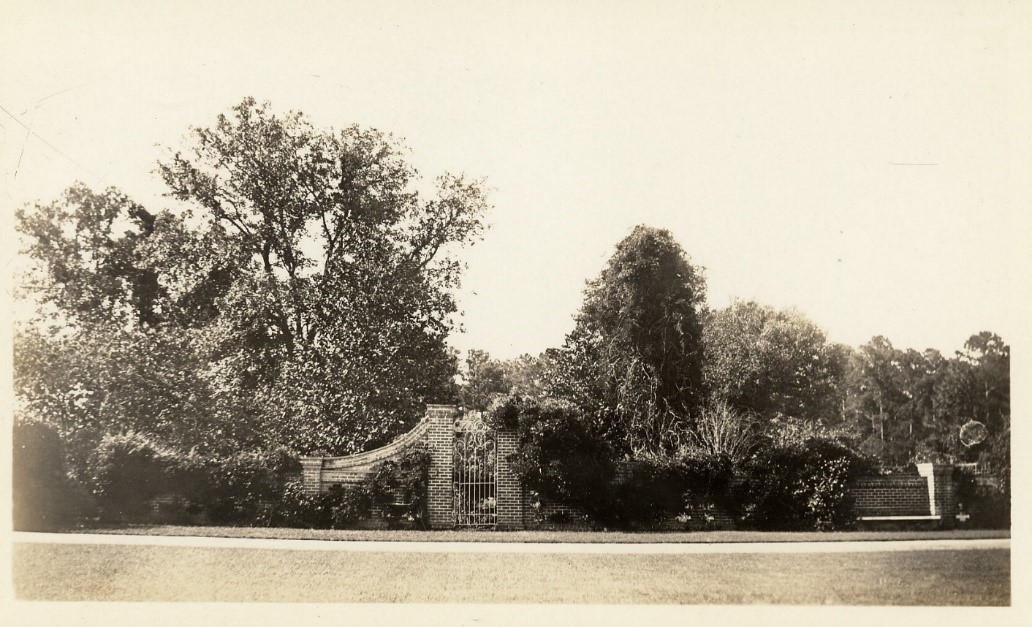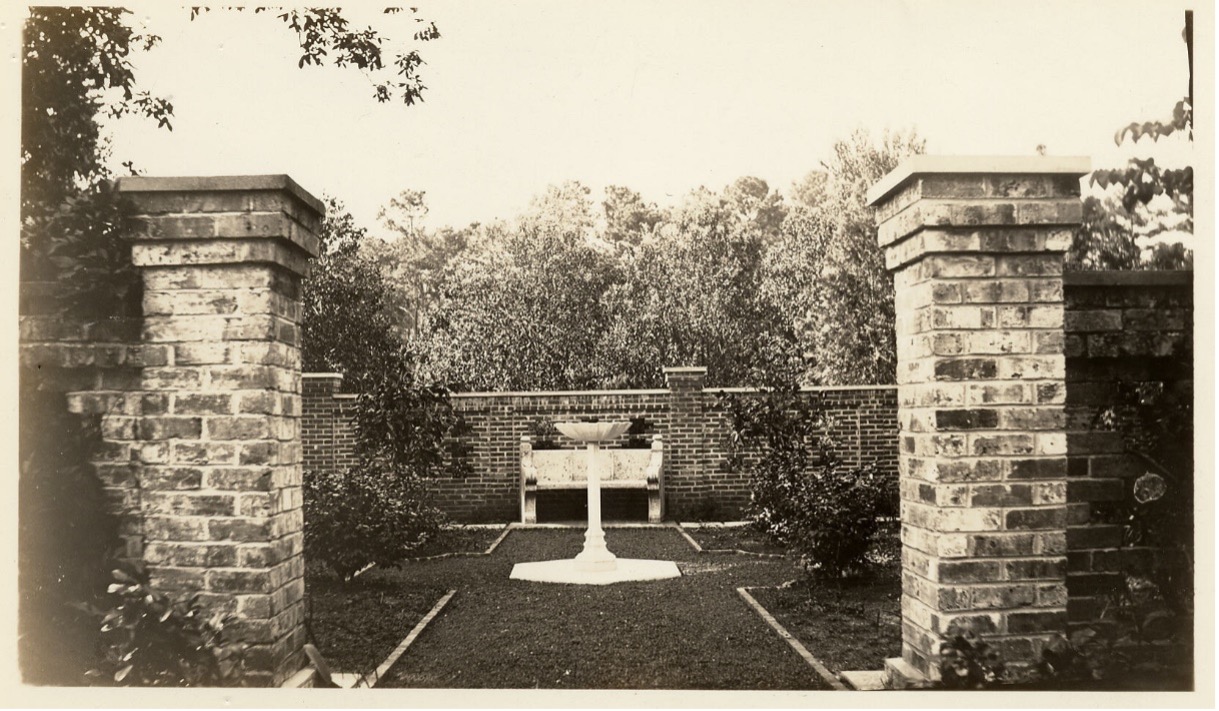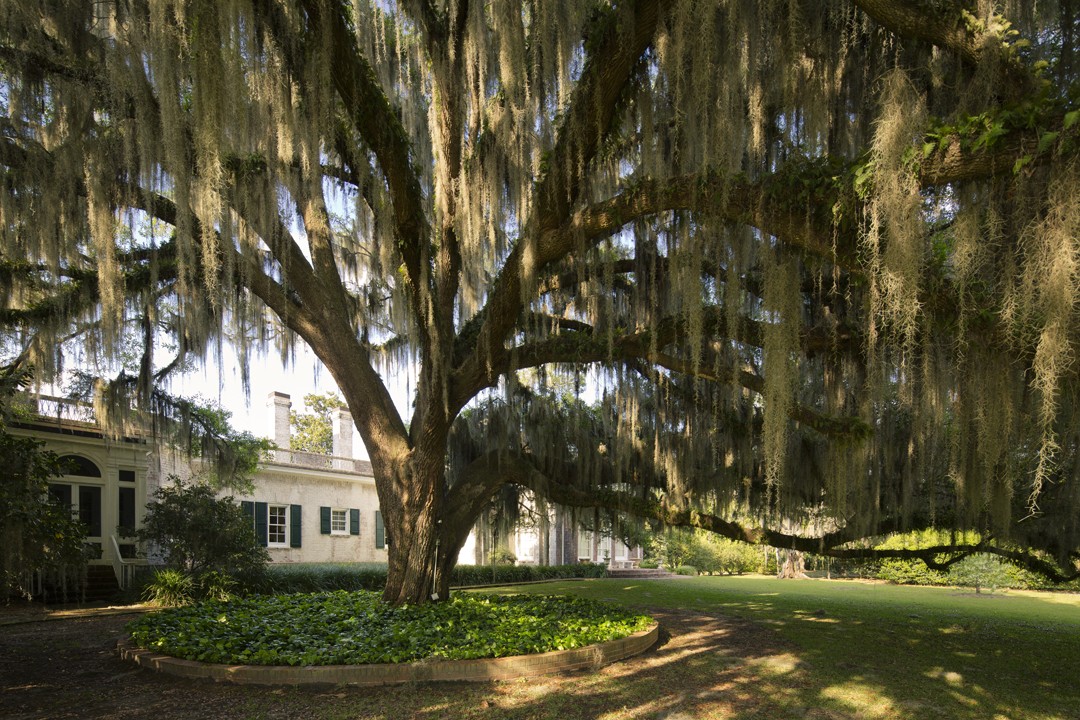Stop #1
Family Cemetery
The Family Cemetery is the final resting place for the families who have been associated with Pebble Hill. Kate Hanna Ireland (Harvey) added the brick wall in 1915 to surround the Johnson and Mitchell family plots. The separate section at the back of the cemetery was added in 1932 to serve as the resting place for Hanna family members.
*Plantings included in Miss Harrison’s master plan
 Native plant
Native plant
American Sycamore*
Platanus occidentalis
Located outside the cemetery walls, the sycamore is a native deciduous tree which is easily identified by its multi-colors of grey, brown, and white bark. The leaves are quite large, about the size of a large human hand. The sycamore has interesting fruit which is a brown button-ball composed of many hairy seeds.
Creeping Fig Vine
Ficus pumila
Fig vine is a vigorous, fast growing evergreen vine that appears on the brick wall surrounding the cemetery. Fig vine can cover structures quickly by cementing itself to porous surfaces and requires constant pruning in the warmer months. This vine grows in many other locations throughout the property.
Mauve Star Camellia
Sasquana camellia ‘Mauve Star’
According to the 1948 American Camellia Society Yearbook, this beauty originates from the Fruitland Nursery in Augusta, Georgia. This camellia features a mauve color and blooms in late October/November. It is thought to be one of the largest of these specimens in Georgia.
Mockernut Hickory
Carya tomentosa
This native deciduous and stately hickory tree features fragrant, compound leaves that turn bright golden-yellow in the fall. The tree bears fruit in late fall and winter and has the common name of mockernut due to the rather small kernels of its nuts, despite the large size of its fruits. The mockernut hickory can reach up to 80 feet in height and live up to 500 years.

Family Cemetery, including hickory tree, in 1936
Southern Magnolia*
Magnolia grandiflora
This beautiful native evergreen can be found throughout Pebble Hill’s vast grounds. With broad dark green leaves, magnolia trees can be quite massive, growing up to 50 feet. Best known for their fragrant flowers, magnolias bloom in summer. They also bear a fruit cone with red berries late in the season.

Magnolia trees near the brick wall in the Hanna section of the cemetery in 1936
Pecan*
Carya illinoinensis sp.
The pecan tree located next to the sycamore tree outside the cemetery is deciduous with compound leaves that turn yellow/brown in the fall. The pecan is one of the most valuable cultivated plants in Georgia and produces fruit that is famously known for its delicious nut.
Resurrection Fern
Pleopeltis polypodioides
Typically found on massive live oak limbs, this delicate native evergreen fern can be seen creeping along the hickory tree here in the cemetery. When the weather is dry for extended periods, the fern turns brown ans shrivels, then “ressurects” once enough moisture returns. The fronds are known as air plants or epiphyte and draw nutrients from air and water that collects on the outer surfaces of bark.
From the May 27, 1932 Thomasville Times-Enterprise newspaper following the death of Perry Williams Harvey, Kate’s husband: “At the head of the grave stands a massive hickory tree, a tall, sturdy sentinel to mark the resting place of a greatly beloved and respected man. It is a fitting monument, exemplifying in its majesty and simplicity the character of one it honors, the trunk symbolizing his courage, sturdiness and nobility and the leaves and branches the gentleness, generosity and kindliness that he so many times manifested in behalf of his fellowman.”
This stop is made possible through the generous support of Thomasville Garden Club, Inc. in honor of Killarney Queen Garden Club.
